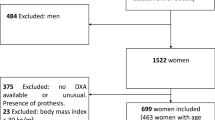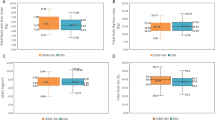Abstract
Background/Goal
Caloric restriction—the most prevalent obesity treatment—has a 97% failure rate when spread over 5–7 years. Sarcopenic obesity is thought to be the consequence of chronic dieting and the cause of weight management problems. This pilot study’s goal was to develop a screening questionnaire that detects sarcopenic obesity in young and middle-aged female adults.
Subjects/Method
A total of 23 women (ages 19–59) completed a sarcopenic obesity questionnaire and were assessed for total body weight (TBWt), percent fat mass, and percent fat-free mass (%FFM) using the Bod Pod (air plethsmography), and bioelectrical impedance analysis (BIA). Appendicular skeletal mass (ASM) was calculated using BIA. Resting energy expenditure was determined using indirect calorimetry, and the basal metabolic rate (BMR) was calculated using BIA.
Results
The screening questionnaire score was negatively correlated with BMR (r2 = 0.885), %FFM (r2 = 0.86), ASM (r2 = 0.79) relative to TBWt and to ASM/BMI (r2 = 0.58). The screening questionnaire had an acceptable sensitivity (83%) and specificity (87%) in detecting sarcopenia measured using ASM/BMI.
Conclusion
This pilot intimates that subjects who frequently dieted suffered from a disproportionally lower FFM and BMR relative to the TBWt. The questionnaire can help clinicians recognize the presence of sarcopenic obesity in patients.
This is a preview of subscription content, access via your institution
Access options
Subscribe to this journal
Receive 12 print issues and online access
$259.00 per year
only $21.58 per issue
Buy this article
- Purchase on Springer Link
- Instant access to full article PDF
Prices may be subject to local taxes which are calculated during checkout

Similar content being viewed by others
Data availability
Data and original screening questionnaire are available for review upon request.
References
Short KR, Vittone JL, Bigelow ML, Proctor DN, Nair KS. Age and aerobic exercise training effects on whole body and muscle protein metabolism. Am J Physiol Endocrinol Metab. 2004;286:E92–101. https://doi.org/10.1152/ajpendo.00366.2003.
Bae EJ, Kim YH. Factors affecting sarcopenia in Korean adults by age groups. Osong Public Health Res Perspect. 2017;8:159–68. https://doi.org/10.24171/j.phrp.2017.8.3.02
Rossi AP, Rubele S, Calugi S, Caliari C, Pedelini F, Soave F, et al. Weight cycling as a risk factor for low muscle mass and strength in a population of males and females with obesity. Obesity. 2019;27:1068–75. https://doi.org/10.1002/oby.22493
Blomain ES, Dirhan DA, Valentino MA, Kim GW, Waldman SA. Mechanisms of weight regain following weight loss. ISRN Obesity. 2013;2013:1–7. https://doi.org/10.1155/2013/210524
Dulloo AG. Collateral fattening: when a deficit in lean body mass drives overeating. Obesity. 2017;25:277–9. https://doi.org/10.1002/oby.21734
Mackie GM, Samocha-Bonet D, Tam CS. Does weight cycling promote obesity and metabolic risk factors? Obes Res Clin Pract. 2017;11:131–9. https://doi.org/10.1016/j.orcp.2016.10.284
Dulloo AG, Jacquet J, Miles-Chan JL, Schutz Y. Passive and active roles of fat-free mass in the control of energy intake and body composition regulation. Euro J Clin Nutr. 2017;71:353–7. https://doi.org/10.1038/ejcn.2016.256
Kim KM, Jang HC, Lim S. Differences among skeletal muscle mass indices derived from height-, weight-, and body mass index-adjusted models in assessing sarcopenia. Korean J Intern Med. 2016;31:643–50. https://doi.org/10.3904/kjim.2016.015
Janssen I, Heymsfield SB, Ross R. Low relative skeletal muscle mass (sarcopenia) in older persons is associated with functional impairment and physical disability. J Am Geriatr Soc. 2002;50:889–96. https://doi.org/10.1046/j.1532-5415.2002.50216.x
Cruz-Jentoft AJ, Baeyens JP, Bauer JM, Boirie Y, Cederholm T, Landi F, et al. Sarcopenia: European consensus on definition and diagnosis. Age Ageing. 2010;39:412–23. https://doi.org/10.1093/ageing/afq034
Shafiee G, Ostovar A, Heshmat R, Keshtkar AA, Sharifi F, Shadman Z, et al. Appendicular skeletal muscle mass reference values and the peak muscle mass to identify sarcopenia among iranian healthy population. Int J Prev Med. 2018;9:25. https://doi.org/10.4103/ijpvm.IJPVM_295_17.
Weir CB, Jan A. BMI classification percentile and cut off points. StatPearls. 2021.
Parikh R, Mathai A, Parikh S, Sekhar GC, Thomas R. Understanding and using sensitivity, specificity and predictive values. Indian J Ophthalmol. 2008;56:45–50. https://doi.org/10.4103/0301-4738.37595
Rosner B. Fundamentals of biostatistics. 8th ed. Boston: Brooks/Cole, Cengage Learning. 978-1305268920 2015:927.
Baumgartner RN, Koehler KM, Gallagher D, Romero L, Heymsfield SB, Ross RR, et al. Epidemiology of sarcopenia among the elderly in New Mexico. Am J Epidemiol. 1998;147:755–63. https://doi.org/10.1093/oxfordjournals.aje.a009520
Heymsfield SB, Smith R, Aulet M, Bensen B, Lichtman S, Wang J, et al. Appendicular skeletal muscle mass: measurement by dual-photon absorptiometry. Am J Clin Nutr. 1990;52:214–8. https://doi.org/10.1093/ajcn/52.2.214
Cawthon PM, Peters KW, Shardell MD, McLean RR, Dam TTL, Kenny AM, et al. Cutpoints for low appendicular lean mass that identify older adults with clinically significant weakness. J Gerontol A Biol Sci Med Sci. 2014;69 A:567–75. https://doi.org/10.1093/gerona/glu023
Zusman O, Kagan I, Bendavid I, Theilla M, Cohen J, Singer P. Predictive equations versus measured energy expenditure by indirect calorimetry: a retrospective validation. Clin Nutr. 2019;38:1206–10. https://doi.org/10.1016/j.clnu.2018.04.020.
Lees MJ, Wilson OJ, Hind K, Ispoglou T. Muscle quality as a complementary prognostic tool in conjunction with sarcopenia assessment in younger and older individuals. Eur J Appl Physiol. 2019;119:1171–81. https://doi.org/10.1007/s00421-019-04107-8.
Lee DC, Shook RP, Drenowatz C, Blair SN. Physical activity and sarcopenic obesity: definition, assessment, prevalence and mechanism. Future Sci OA. 2016;2:FSO127. https://doi.org/10.4155/fsoa-2016-0028.
Acknowledgements
Special thanks to Elizabeth Herrick, Elizabeth Rummel, and Brenna Oberg, for their valuable technical and analytic work. We acknowledge the assistance of John Kind, Director of the Mankato, Minnesota YMCA, in recruiting research subjects.
Funding
This research was supported by a Faculty Research Grant from Minnesota State University, Mankato. Grant: Burk BN, Bissonnette D (2017). Identifying ecological and personal factors that prevent obese individuals from effectively losing weight. Minnesota State University, Mankato, Faculty Research Grant ($4950).
Author information
Authors and Affiliations
Contributions
DJB developed the original screening questionnaire, wrote the first draft of the manuscript, and participated in all other drafts. MH, PK, and BNB contributed to the rewriting of four drafts, and PK completed the statistical analysis. BNB participated in data collection.
Corresponding author
Ethics declarations
Competing interests
The authors declare no competing interests.
Ethics approval and consent to participate
The Institutional Review Board of Minnesota State University, Mankato, approved this research (IRB# 8207501). All subjects consented to participate in the study by signing a consent form.
Additional information
Publisher’s note Springer Nature remains neutral with regard to jurisdictional claims in published maps and institutional affiliations.
Rights and permissions
About this article
Cite this article
Bissonnette, D.J., Burk, B.N., Hadley, M. et al. Pilot study for the development of a screening questionnaire to detect sarcopenic obesity. Int J Obes 46, 1328–1331 (2022). https://doi.org/10.1038/s41366-022-01118-y
Received:
Revised:
Accepted:
Published:
Issue Date:
DOI: https://doi.org/10.1038/s41366-022-01118-y



